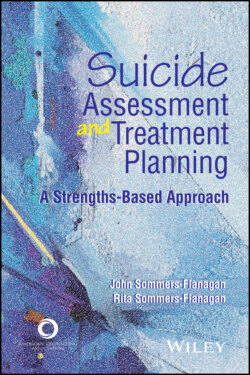Читать книгу Suicide Assessment and Treatment Planning - John Sommers-Flanagan - Страница 50
Competency 8: Document Risk Assessment, the Treatment Plan, and the Rationale for Clinical Decisions
ОглавлениеDocumentation serves several purposes. Writing down your observations, organizing your inferences, and reflecting on decision-making helps you remember your clients’ dynamics and goals. Your notes will provide you with an accurate and efficient method of monitoring client progress or deterioration. Adequate documentation can also mitigate professional liability (Rudd, 2006).
Professional documentation begins with a signed informed consent form that outlines how you work with clients who are suicidal, what clients should do in cases of emergency, and the reasons you would choose or be required to breach confidentiality. You should document everything from case notes to consultations to decision-making rationale. Whatever format you use for intake and progress notes, to help organize your documentation, we offer the following list of items and content to include in your client files (for a comprehensive outline of an intake report, see J. Sommers-Flanagan & Sommers-Flanagan, 2017):
1 Documentation of initial client paperwork, including your client’s signature on an informed consent
2 Previous treatment records
3 Information about your suicide assessment, treatment plan, and decision-making, including the following content:Suicide-related historical information (e.g., suicidal behaviors by family members, client previous attempts, lethality of previous attempts)Assessment of risk and protective factorsSuicide assessment instruments or questionnairesAssessment of suicidal thoughts, plan, client self-control (agitation), and intentA record of consultations with previous counselors and other professionalsYour rationale for the treatment you are providing and your rationale for your treatment disposition and referrals (e.g., day treatment, hospitalization)Any contacts you have made with authority figures (police officers, administrators, teachers, and/or family members)
4 Your collaborative safety plan, including firearms safety; keep a copy in your files and give your client a copy (If your client reports suicidal ideation and you do not create a safety plan, you should document your rationale for not creating one.)
5 Notes on any review or update of the informed consent and the crisis or safety plan
6 Progress notes that include your client’s response (e.g., progress, resistance, deterioration) to your initial suicide assessment as well as ongoing assessment and treatment that you are providing
The preceding list is skeletal. Depending on your setting and needs, to fill in the content, you might elaborate on your rationale for treatment, including describing how and why the treatment you are providing is a good match for your client’s unique problems and symptoms. Specifically, you could (a) highlight immediate or prominent risk factors (including suicide triggers) and how you are addressing them, (b) describe how you plan to draw out or activate protective factors to reduce suicidality, and (c) include immediate and longer term interventions you are taking to reduce suicide risk. Using direct quotes or paraphrases from your client that support your evaluation and decision-making is recommended. You can also include mental status observations of physical and nonverbal behaviors, such as lack of eye contact, sighs, or poor hygiene.
